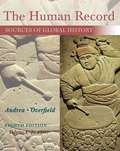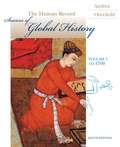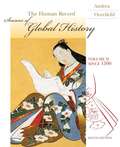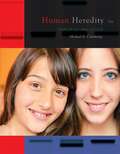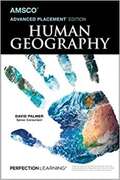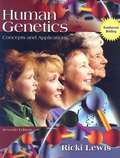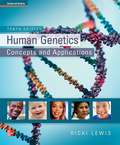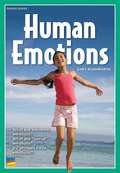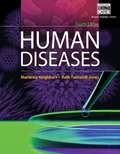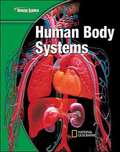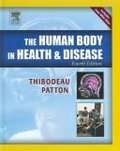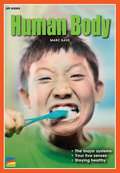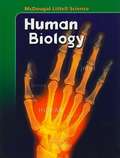- Table View
- List View
More NIMAC books are available at www.nimac.us. If you find your title in the NIMAC and not in Bookshare then please contact us to request it.
The Human Record: To 1500, 8th Edition
by Alfred J Andrea James H. OverfieldTHE HUMAN RECORD is a leading primary source reader for world history, providing balanced coverage of the global past. Each volume contains a blend of visual and textual sources that are often paired or grouped together for comparison, as in the Multiple Voices feature. A prologue entitled "Primary Sources and How to Read Them" serves as a tool that helps you approach, and get the most from, each document. Approximately one-third of the sources in the Eighth Edition are new, and these documents continue to reflect the myriad experiences of the peoples of the world.
The Human Record: Sources Of Global History To 1700
by Alfred J. Andrea James H. OverfieldNIMAC-sourced textbook
The Human Record: Since 1500
by Alfred J. Andrea James H. OverfieldNow in its Sixth Edition, The Human Record continues to be the leading primary source reader for the World History course. Each volume contains a blend of visual and textual sources; these sources are often paired or grouped together for comparison. A prologue entitled, "Primary Sources and How to Read Them," appears in each volume and serves as a valuable pedagogical tool. Unlike many world history texts that center on the West, The Human Record provides balanced coverage of the global past. Approximately one-third of the sources in the Sixth Edition are new, and these documents continue to reflect the myriad experiences of the peoples of the world.
The Human Odyssey, Volume 3: From Modern Times to Our Contemporary Era
by Mary Beth Klee John Cribb John HoldrenNIMAC-sourced textbook
Human Impact on the Environment (Inspire Science, Grade 6 Integrated #Unit 4)
by Alton L. Biggs Ralph M. Feather Douglas FisherNIMAC-sourced textbook
Human Geography: A Spatial Perspective
by Sarah Bednarz Mark Bockenhauer Fred HiebertNIMAC-sourced textbook
Human Genetics: Concepts and Applications (7th edition)
by Ricki LewisAn excellent introductory text for undergraduates, especially those with "sciencephobia." Slow-paced material incorporates information on genetics in the news, and features chapter outlines, real-life vignettes, technology timelines, key concepts, chapter glossaries, and review and applied questions, plus boxed readings on fun subjects like human werewolves, and color photos and diagrams. Includes sections on fundamentals, transmission genetics, DNA and chromosomes, population genetics, immunity and cancer, and the latest genetic technology. Annotation c. by Book News, Inc., Portland, Or.
Human Genetics: Concepts and Applications
by Ricki LewisAn excellent introductory text for undergraduates, especially those with "sciencephobia. " Slow-paced material incorporates information on genetics in the news, and features chapter outlines, real-life vignettes, technology timelines, key concepts, chapter glossaries, and review and applied questions, plus boxed readings on fun subjects like human werewolves, and color photos and diagrams. Includes sections on fundamentals, transmission genetics, DNA and chromosomes, population genetics, immunity and cancer, and the latest genetic technology. Annotation c. by Book News, Inc. , Portland, Or.
The Human Clock (Fountas & Pinnell Classroom, Guided Reading Grade 5)
by Davia LukeThe Body's Clock The human body can do many remarkable things—it can even tell time. The body follows the same cycle every day, almost to the minute, and knows exactly when to wake up, when to think and daydream and exercise, and when to sleep. Find out all the ways your body is an incredible human clock. NIMAC-sourced textbook
Human Body Systems
by Glencoe Mcgraw-HillDiscover the Flexibility to Teach Science Your Way!. "Glencoe Science: Human Body Systems," a module in the Glencoe Science 15 book series, provides students with accurate and comprehensive coverage of middle school National Science Education Standards. Concepts are explained in a clear, concise manner, and are integrated with a wide range of hands-on experiences, critical thinking opportunities, real-world applications, and connections to other sciences and to non-science areas of the curriculum. Co-authored by National Geographic, unparalleled graphics reinforce key concepts. A broad array of print and technology resources help differentiate and accommodate all learners. The modular approach allows you to mix and match books to meet your specific curriculum needs.
The Human Body in Health & Disease
by Gary A. Thibodeau Kevin T. PattonOffering a student-friendly writing style, this text presents a body systems approach with a strong emphasis on vocabulary and basic anatomy and physiology concepts, as well as the basic mechanisms of disease and pathologic conditions associated with each body system. This comprehensive text is dominated by two unifying themes: the complementarity of structure and function and homeostasis. The integrating principle of homeostasis is used to show how normal structure and function is achieved and maintained. Failures of homeostasis are shown as basic mechanisms of disease. The reader is drawn into the subject by superior illustrations, including cadaver dissections, and other student-friendly features. Boxed Essays throughout each chapter contain information ranging from clinical applications to sidelights on recent research or topics related to exercise and fitness. Clinical Applications at the end of each chapter offer short case studies with questions that tie theory to practice, and encourage students to apply their knowledge to specific, practical problems. Answers are in the back of the book. Readability and coverage are at the appropriate level for students approaching the study of anatomy and physiology for the first time, with interesting analogies and examples along with the factual information. Superior art program, with over 450 full-color illustrations, complements text material. Chapter Outlines introduce each chapter and preview the content. Objectives contain measurable objectives for students to identify key goals and master information. Detailed Outline Summaries at the end of each chapter provide an excellent recap of important chapter content. New and important vocabulary terms are listed at the end of each chapter, and a comprehensive Glossary provides the full definition for each term. All vocabulary terms in each chapter are provided in bold print. Student self-evaluation activities at the end of each chapter measure their mastery of content. The Chapter Test (answers in back of book), Review Questions and Critical Thinking (answers in Instructors Manual) provide objective and subjective questions and encourage use of critical thinking skills. Pathologic Conditions appendix provides tables summarizing specific pathological conditions by characteristic. Medical Terminology appendix provides a list of word parts commonly used in terms related to medicine and pathology, along with tips on dissecting complex terms to determine their meanings. Clinical Laboratory Values appendix provides commonly observed values for human body content and physiological conditions, along with their normal ranges. New Chemistry of Life chapter discusses basic chemistry concepts needed for understanding basic anatomy and physiology. The Panorama of Anatomy and Physiology/Body Spectrum: Mosbys Electronic Anatomy Coloring Book are included in each textbook. A two-in-one CD-ROM featuring two of popular interactive programs, it simplifies the way students learn anatomy and medical terminology by offering 80 detailed anatomy illustrations that can be colored online or printed out to color and study offline. It also features quizzes, movie clips, fun facts, and information on careers in the field of A&P. New Science Applications boxes are added to each chapter, highlighting the contributions of trailblazing scientists to the field of anatomy and physiology. Study Tips with collaborative learning activities are now listed at the end of each chapter to assist students in how best to study the chapter materials, making this text more student friendly than ever before. New Evolve website provides students access to web links created especially for this text along with online study activities and study tips. It also includes continually updated content, study through the Internet, and
Human Body: FOSS Science Stories
by Lawrence Hall of Science University of California at BerkeleyNIMAC-sourced textbook
